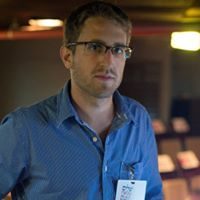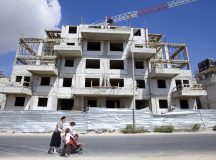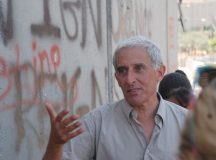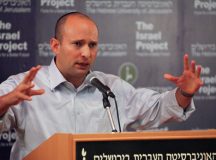Settlement construction beyond Israel’s internationally recognised borders is a controversial topic within Israel and often the subject of international criticism and concern. Fathom Editor Alan Johnson spoke to Lior Amihai, head of Peace Now’s Settlement Watch project, which monitors the building of settlements in the West Bank and East Jerusalem. For an alternative view on the settlements see Fathom’s interview with Dani Dayan here.
The settlement project and its impact
Alan Johnson: What’s the current picture in regards to the settlement project? How many settlements, how many settlers and where are they?
Lior Amihai: The settlers comprise a population of about 350,000 people, excluding those living in East Jerusalem (about 200,000). Altogether you can say there are 550,000 Israelis living beyond the Green Line, however, only 350,000 of them are in what we would term the West Bank (i.e. excluding East Jerusalem). They are spread out in about 200 communities, with approximately 120 recognised settlements (recognised by the Israeli government), and about 100 more outposts – illegal, unauthorised outposts – which are smaller communities not recognised by the Israeli government.
AJ: After the recent failure of the peace talks, there was a debate about the extent to which settlement building during the negotiations was a factor in their failure. What’s your opinion?
LA: I think it had a massive impact on the negotiations. The timing of the different announcements and actions that the Israeli government chose to promote were in sensitive moments of the negotiations – usually after releasing Palestinian prisoners from Israeli prisons. The meaning and facts which these settlement announcements create on the ground is working against the possibility of the two-state solution. This sent out a message to the international community, but first and foremost to the Palestinians, that the Israeli government did not have any intention of reaching a two-state solution, or reaching an agreement.
AJ: Are there any particular settlement hotspots that you’re looking at as an organisation or is there anything that you find particularly concerning at the moment?
LA: The term ‘settlement blocs’ is not defined by anyone, not by the Palestinians, clearly not by the international community, but also not by the Israeli government or the Israelis; we’re not really sure what these settlement blocs are. Nonetheless, they are used in the discourse to say ‘well it’s alright; it’s only within the settlement blocs, these will certainly stay under Israeli sovereignty once there’s a two-state solution.’
However, when we analyse these settlement blocs, we come to a conclusion that actually, the most sensitive areas to the two-state solution are within these settlement blocs. We point to Ariel which is very problematic, E1 and the areas surrounding Maaleh Adumim, Givat Hamatos, Efrat (which is just east of other settlements in the Gush Etzion area), and of course East Jerusalem and developments within Palestinian neighbourhoods in and around the Old City. All these sensitive areas have seen many developments in recent years with the excuse that, ‘it’s in the blocs so its ok.’
However, the Israeli and Palestinian negotiation teams were not negotiating the isolated areas. It is fairly clear that the isolated settlements would have to be evacuated (in the event of a peace agreement). It’s the sensitive places that they were negotiating – trying to reach a solution best for both parties. In these particular areas, the Israeli government put its focus on creating facts on the ground with greater intensity, perhaps trying to make them areas that would never be evacuated – even though, from a Palestinian perspective, they clearly must be.
The future of the Two-State Solution
AJ: Even though there’s development and mistrust – and you’ve explained why the term ‘settlement bloc’ needs to be unpacked and that some of the very sensitive issues are within the blocs – do you think we’re still, in principle, in the area of an agreement being possible with land swaps?
LA: My view is clear: if the parties were to reach an agreement today then the two-state solution is very possible.
Luckily, the majority of settlers live in areas that would most probably be ‘land swapped’. However, this does not undermine the current developments which I highlighted – the trend of putting emphasis on the sensitive areas will make the conflict much more difficult to resolve. During the negotiation period and before, the emphasis of the Israeli government – in where they are constructing new houses and promoting construction plans – is sending a message to the public that it doesn’t have any interest in finding a solution.
I’m certain that if there was a true desire to reach a solution, it would be possible. It could be done so the majority of settlers stay in their homes and would not need to be evacuated. However, on the ground, the Israeli government is working to the contrary.
AJ: Since the collapse of the peace talks there has been a debate within Israel that calls for a search for an end to the conflict, sometimes just summed up as the ‘Plan B debate.’ Many people’s version of ‘Plan B’ is some form of Israeli unilateralism. With regards to the settlements, the debate is around whether or not it’s feasible for the Israeli government to disengage – against the will of a sizeable number of settlers on the West Bank – on a much larger scale than it did in Gaza, but with the same kind of principle? What’s your view of that?
LA: I am very scared of a unilateral disengagement. Because I come from an understanding that a two-state solution is possible, I don’t see the need for a unilateral disengagement. I believe that if the parties are sincere, and actually seek a two-state solution, then it is possible to reach an agreement. More than that, if Israel does carry out a unilateral disengagement, it will have many problematic outcomes. If Israel plans to unilaterally disengage from only part of the West Bank, no-one will support it and Israel will still remain without recognised borders.
Furthermore, the Palestinians would not recognise these borders and this would give an incentive to groups in Palestine to oppose Israel and perhaps to attack it. The risk of a unilateral disengagement, where there won’t be recognised borders, and which will give further strength for Palestinians to oppose it, just doesn’t make sense for me; especially when I believe that a two-state solution is possible.
AJ: When I debate on campuses I often use two anecdotes: One is a speech given by David Grossman when he said that ‘flare of identity’ in Israel ‘reaches as far as the Green Line,’ but ‘no farther.’ He thinks that Israel’s basic sense of identity is still a Green Line identity and the Greater Israel project doesn’t really carry the majority of Israelis. The other anecdote I use is when Times of Israel, before the last general election, carried out a poll and said ‘we know there’s an austerity budget coming, who do you think should be cut?’ I think over 70 per cent said settlement budgets should be cut. Am I right to use those anecdotes, is that still a reasonable thing to say about Israeli public opinion? That even though it doesn’t see a two-state solution on the horizon it’s no longer a Greater Israel public?
LA: I think the majority of people in Israel would support a two-state solution, and that’s shown in different polls and in various other ways. The Israeli people in general are supportive of what the government does; they were very supportive of the disengagement from the Gaza Strip and we don’t see them oppose very much the (current) settlement policy. However, if the government would seek to evacuate, disengage or reach a two-state solution, I think there would be high support for it from the Israeli public; they would understand that this is what’s best to be done.
Even more so, a large portion of the settlers themselves understand this. If they were to be presented with a dilemma where settlement activity risks the existence of the State of Israel as we know it, as a national home for the Jewish people and a democracy, then the majority of settlers themselves would come to a point where they would wish to evacuate. Of course, there are extremists within the settler community, but they are a minority.
The settler ideology has a lot of power and influence within Israel. Almost ten per cent of the Israeli parliament is comprised of settlers. They have their own party, Jewish Home, and even a high proportion of the Likud, the Prime Minister’s party, is comprised of settlers and those who support the settlement movement. Thus, But, they don’t represent the majority of Israelis who really do want to live in peace and harmony in a nation state for the Jewish people, but also in a democracy.
AJ: Tell us a bit more about Settlement Watch and the work that you do.
LA: Settlement Watch is a project within the Peace Now movement. The Peace Now movement represents Israeli citizens who want to reach a two-state solution and peace between neighbouring countries – first and foremost the Palestinians. Settlement Watch was created about 20 years ago when Peace Now understood that facts were being created on the ground with little knowledge and little public debate. They started driving to the West Bank to see what was happening and report this back to the Israeli public, in order to create a debate in Israel about these settlements. Over the years we’ve improved, developed, and gained a lot of experience about how settlements work; about the planning process and procedures that come with creating settlements – legal or illegal. And today, it has become quite an authoritative body on these settlements. We have many different methods: online research, field study and also aerial photos. We accumulate data in order to show the Israeli public what is actually happening.






































Comments are closed.